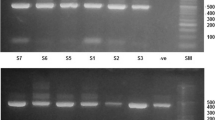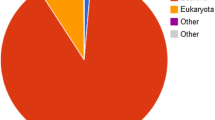Abstract
The edible mushroom Agaricus bisporus is grown commercially on composted manure/straw mixtures. Mushroom composting is a fermentation process in which various groups of microorganisms play important roles at different stages of composting. The present study was conducted to explore the mesophilic bacterial diversity in the early phase of mushroom composting. Morphologically all the isolated bacteria were either Gram-positive rods, cocci or Gram-negative rods. The functional diversity of the bacterial isolates was examined by plate enzyme assays, siderophore production and antagonistic property. Good enzymatic activity for amylase, cellulase, xylanase and protease was reported for different bacterial isolates. Nine bacterial isolates showed siderophore production activity. During antibiosis assay, most of the isolates inhibited growth of Verticillium fungicola and Mycogone perniciosa. However, a consortium of selected bacterial isolates produced good amounts of lytic enzymes (amylase, cellulase, xylanase and protease) in solid state fermentation experiments that might help in enhancing the composting process. Amplified 16S-rDNA restriction analysis (ARDRA) of bacterial isolates indicated that four groups of nine bacterial isolates had 100% similarity in all the restriction profiles. However, other isolates exhibited discriminatory relationships with each other. The present study reveals culturable mesophilic bacterial diversity and community succession in the early phase of mushroom composting process as well as emphasizing the application of a bacterial consortium to enhance the composting process.


Similar content being viewed by others
References
Amann RI, Ludwig W, Schleifer KH (1995) Phylogenetic identification and in situ detection of individual microbial cells without cultivation. Microbiol Rev 59:143–169
Bazzicalupo M, Fani R (1994) The use of RAPD for generating specific DNA probes for microorganisms. In: Clapp J (ed) Methods in molecular biology. Humana, Totowa, NJ, pp 155–175
Chadha BS, Singh S, Bohra G, Saini HS (1997) Shake culture studies for the production of amylase by Thermomyces lanuginosus. Acta Microbiol Immunol Hung 44:181–185
Chang Y, Hudson HJ (1967) The fungi of wheat straw compost: ecological studies. Trans Br Mycol Soc 50:649–666
Choudhary DK, Agarwal PK, Johri BN (2009) Characterization of functional activity in composted casing amendments used in cultivation in Agaricus bisporus (Lange) Imbach. Indian J Biotechnol 8:97–109
Derikx PJL, De Jong GAH, Op den Camp HJM, Van der Drift C, Van Griensven LJLD, Vogels GD (1989) Isolation and characterization of thermophilic methanogenic bacteria from mushroom compost. FEMS Microbiol Lett 62:251–257
Fermor TR, MaCauley BJ (1991) Microbiological factors contributing to selectivity and nutritional quality of mushroom compost. In: Nair NG (ed). Proceedings of AMGA/ISMS. International Workshop – Seminar on Agaricus compost AMGA, Sydney, pp. 48–67
Holt JG, Krieg NR, Sneath PHA, Staley JT, Williams ST (1994) Bergeys manual of determinative bacteriology, 9th edn. Williams and Wilkins, USA
Johri BN, Rajni (1999) Mushroom compost: microbiology and application. In: Bagyaraj DJ, Verma A, Khanna KK (eds) Modern approaches and innovation in soil management. Rastogi, Meerut, pp 345–358
Lagace L, Pitre M, Jacques M, Roy D (2004) Identification of the bacterial community of maple sap by using amplified ribosomal DNA (rDNA) restriction analysis and rDNA sequencing. Appl Environ Microbiol 70:2052–2060
Lowry OH, Rosebrough NJ, Farr AL, Randall RJ (1951) Protein measurements with the folin phenol reagent. J Biol Chem 193:265–275
Masaphy S, Levanon D, Danai O, Henis Y (1987) Nutritional supplementation to the casing soil: Ecological aspects and mushroom production, Mushroom Sci (Part II0, in Proc 12th Int Congress on Science and Cultivation of edible fungi, Braunschweig, Germany), pp. 417–426
Massol-Deya AA, Odelson DA, Hickey RF, Tiedje JM (1995) In: Akkermans ADL, Van-Elsas JD, De-Bruijn FJ (eds) Bacterial community fingerprinting if amplified 16S and 16-23S ribosomal DNA gene sequences and restriction endonuclease analysis (ARDRA). Kluwer, Boston, pp 3321–3328
Miller GL (1959) Use of dinitrosalicylic acid reagent for determination of reducing sugar. Anal Chem 31:426–428
Schwyn B, Neilands JB (1987) Universal chemical assay for the detection and determination of siderophores. Anal Biochem 160:47–56
Silva CF, Azevedo RS, Braga C, Silva R, Dias ES, Schwan RF (2009) Microbial diversity in a bagasse-based compost prepared for the production of Agaricus brasiliensis. Brazilian J Microbiol 40:590–600
Szekely AJ, Sipos R, Berta B, Vajna B, Hajdu C, Marialiget K (2009) DGGE and RFLP analysis of bacterial succession during mushroom compost production and T-RFLP profile of mature compost. Microb Ecol 57:522–533
Umar MH, Geels FP, Van Griensven LJLD (2000) Pathology and pathogenesis of Mycogone perniciosa infection of Agaricus bisporus, In: Proceedings of the 15th International Congress on the Science and Cultivation of Edible Fungi, Maastricht, Netherlands, 15–19 May, 2:561–567
Upton ME, Fogarty WM (1977) Production and purification of theromstable amylase and protease of Thermomonospora viridae. Appl Environ Microbiol 33:59–64
Weisburg WG, Barns SM, Pelletier DA, Lane DJ (1991) 16S ribosomal DNA amplification for phylogenetic study. J Bacteriol 173:697–703
Wiegant WM, Wery J, Buitenhuis ET, De Bont JAM (1992) Growth-promoting effect of thermophilic fungi on the mycelium of the edible mushroom Agaricus bisporus. Appl Environ Microbiol 58:2654–2659
Acknowledgements
Financial support from Ministry of Environment and Forest, Government of India, New Delhi to the Centre for Research on Bacteria and Archaea (CRBA) is gratefully acknowledged. The authors thank Joint Director Dr. R.P. Singh, Mushroom Research and Training Centre, G.B. Pant University of Agriculture and Technology, Pantnagar for supply of compost.
Author information
Authors and Affiliations
Corresponding author
Rights and permissions
About this article
Cite this article
Singh, A.V., Sharma, A. & Johri, B.N. Phylogenetic profiling of culturable bacteria associated with early phase of mushroom composting assessed by amplified rDNA restriction analysis. Ann Microbiol 62, 675–682 (2012). https://doi.org/10.1007/s13213-011-0304-8
Received:
Accepted:
Published:
Issue Date:
DOI: https://doi.org/10.1007/s13213-011-0304-8




